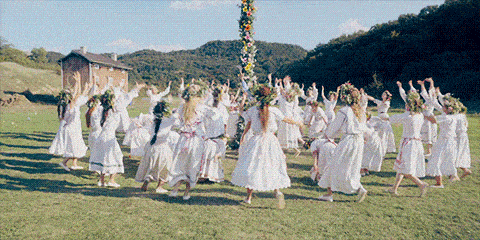December 2022.
The Staff of [The Feast]—Ryan Purcell (Artistic Director), Dedra Woods (Creative Producer), Ellen Abram (Executive Director), and Jesse Roth (Communications Manager)—sit in a conference room that feels too corporate for them.
They have just completed producing the company’s biggest show ever (The Amen Corner). There’s been very little sunlight for days. They’ve had too much coffee. They are tasked with rescheduling our gala. They have succumbed to the sillies.
Ryan: Somewhere around like…May Day?
Jesse: The theme should be The May Day Gala for the Proletariat!
Dedra: “We need a maypole. Like in Midsommar.”
We may not have a maypole at our Spring Forward gala. We promise there will be no bear suit or ritual sacrifice. And the day landed on May the 6th. But the spirit of May Day is alive and well in this event: we are inviting you to come cultivate an abundant upcoming season, to support our workers, and to party with us into the (ever later!) dying of the light.
May 1st is May Day, an ancient European festival marking “Beltane,” the halfway spot between the spring equinox and the summer solstice. Flower crowns, maypoles, and bonfires abound to usher in the abundance of the upcoming summer.
May first is also International Workers’ Day. About May Day, Howard Zinn writes, “On May 1 [1886], the American Federation of Labor, now five years old, called for nationwide strikes wherever the eight-hour day was refused.” It’s no coincidence that Zinn’s A People’s History of the United States sat on Sidney Brustein’s coffee table on the set of our production of The Sign…. (a design choice that always made me cackle.)
2023 is the new 1886: Inequality is rampant and workers are organizing to fight back. Since 2020, over one hundred years later, BIPOC activists, under the banner of We See You White American Theatre, are still organizing for—among many things—working conditions that ensure time for rest and leisure. The fight is ongoing.

[The Feast] is existentially built around supporting artists as workers. This, like most things we consider worthwhile, is much easier said than done. We all have to do our part. This gala, at this time of year, is both a rally and a ritual. It’s a call to arms to support artists and a rite blessing our artmaking with abundance and fertility heading into our summer season.
“After a long winter in Seattle, everyone is always looking forward to spring,” Dedra said when I asked her why the Gala theme was “Spring Forward.” “Usually that inspires some action or movement as a collective. As a company, we’re stepping into our next phase of growth.”
Ecology is one of my favorite metaphors for art-making. Many businesses increasingly use the language of mechanics and innovation, which assumes some supreme human dominion. But any time I’ve tried too hard to “systematize” building a place for art I’ve been rapidly humbled.
I’ve joined the hoards of plant moms this year (like every other millennial). Gazing at them, I often marvel, How do they just…keep growing without me MAKING them grow?! I don’t know why my monstera thrives so heartily on dregs of my La Croix cans, but she does. Similarly, Ryan can’t control how an audience member responds to Act 2 of Sidney Brustein. Whether photosynthesis, inspiration, or the holy ghost, we can’t understand the process, but we can offer it nourishment.

Just as industrial agriculture strips nutrients from the soil, our present economic system is destroying the conditions conducive to art-making. The workers organizing for over a hundred years are demanding water and fertile soil.
[The Feast] is an experiment in regenerative artistic agriculture: we can’t keep extracting nutrients from our artists, leaving them ever more broke, burnt out, and creatively devastated. Creating a healthy ecosystem requires faith that an alternative is possible, faith that our fruits will come to harvest, and faith that we don’t have to (and can’t) do it alone. As we spring forward this year, we’re inviting you to offer this ecosystem water and nutrients and careful tending, so we can regenerate together.
Please join us on May 6th to usher in new spring growth, dance around the (proverbial) maypole, and stand in solidarity with the artists who give so much of themselves and deserve to be paid handsomely. Let’s do it, joyfully, at the beach, in cute clothes, while we eat cake and watch the sun set ever-later over the bay. Can’t wait to see you there.

